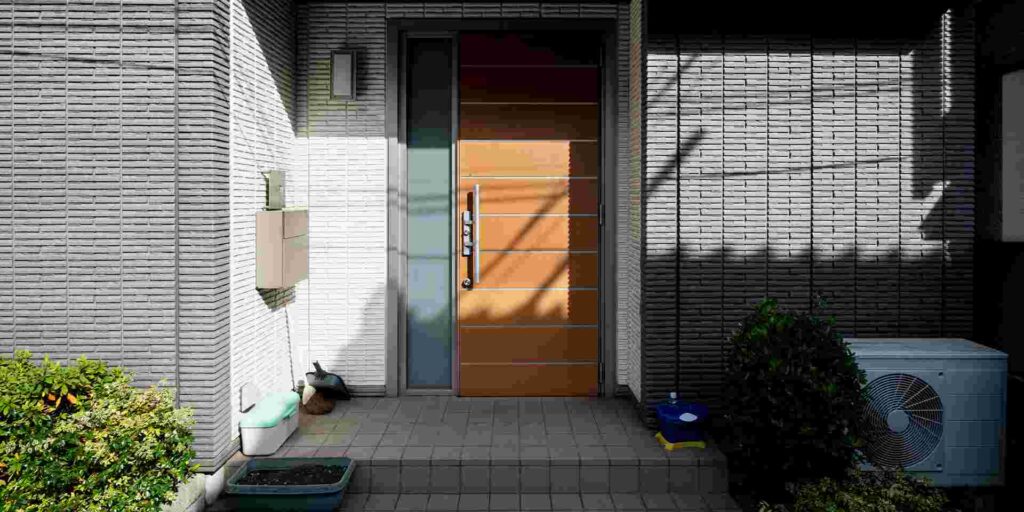A prehung entry door comes already attached to its own frame. That means the door, the hinges, and the frame all come together in one piece. This makes installation easier, especially if your old door and door frame are worn out or damaged.
What is a Prehung Entry Door Used For?
Homeowners often use prehung doors when they need more than just a new door. These doors are made for full replacements or brand-new openings.
- Many people install prehung doors when they build a new home and need a full door setup.
- If your current door frame is broken, warped, or just not doing its job anymore, a prehung door is the best fix.
- These doors help save time because everything is already attached and lined up correctly.
- These entry doors in Los Angeles, CA, often include weatherstripping, which helps block out cold air, rain, or heat. That means better comfort and lower energy bills.
Installing a Prehung Entry Door
First, let us tell you the tools you’ll need:
| Tape measure | Hammer |
| Level | Shims |
| Screwdriver or drill | Utility knife |
| Caulk and caulking gun | Pry bar |
Steps For Installing a Prehung Entry Door
You need to:
- Remove the old door and take out the frame carefully.
- Clean the opening and check that it’s level from side to side and top to bottom.
- Apply a line of caulk along the bottom edge (the sill) where the new door will sit.
- Place the new prehung door into the opening and center it.
- Add shims around the frame to help keep it straight and level.
- Drive screws or nails through the frame and into the wall studs to lock it in place.
- Test the door by opening and closing it a few times to make sure it swings easily and doesn’t stick.
- Attach interior and exterior trim to finish the look and cover the gaps.
- Seal the outside edges with caulk, so rain or drafts can’t get in.
- Paint or stain the door if it doesn’t already come finished.
If you think it’s a lot of work and need entry door installation services in Los Angeles, CA, contact Teza Doors and Windows and get an estimate.
Pre Hung vs. Slab Door: The Differences
A prehung entry door is a door that comes with its frame already built in. The hinges are attached, and everything is lined up and ready to go. This is a great option if you’re starting from scratch or if your old door frame is damaged. It makes life easier because you don’t have to figure out where the hinges or the frame go. Just fit it into the opening, and you’re on your way.
Now, a slab door is just the door. No frame, no hinges, just the panel. It’s a smart choice if your current frame is still strong and straight. But putting in a slab door takes a steady hand. You need to mark and cut for hinges, line up the door knob holes, and make sure it fits just right. And it’s lighter than a prehung door, so if you’re doing it solo, it might save your back.
Pre hung vs. Slab Door: Pros & Cons
| Feature | Prehung Door | Slab Door |
| Installation | Fast and simple because the frame and hinges are pre-attached | Slower because you must line up everything manually |
| Cost | $250–$2,000 depending on style and material | $80–$1000 depending on design and material |
| Time | Can be done in a few hours with basic tools | Takes longer, especially if frame needs adjusting |
| Flexibility | Comes in set sizes with frame | Can be trimmed to fit unusual openings |
Pre hung vs. Slab Door: Which is the Right Choice?
Choose a prehung entry door if:
- You are building a new home and need both the door and the frame.
- Your old frame is cracked, bent, or damaged.
- You want a faster and more beginner-friendly installation.
Choose a slab door if:
- Your current frame is still solid and in good shape.
- You want a special or custom door style.
- You have the tools and skills—or a trusted installer—to do a precise job.
How to Measure for a Prehung Entry Door?
Installing a Prehung entry door correctly depends on how you measure it:
- Measure the space from one side of the rough opening to the other to get the width.
- Measure from the top of the opening down to the bottom to get the height.
- Measure the thickness of your wall to get the jamb depth. That’s the part of the frame that fits inside the wall.
- Use a level to check if the opening is straight and even. This makes a big difference when it’s time to install.
How Much Does It Cost to Install Prehung Entry Doors?
Prehung entry doors installation cost depends on the size, style, and whether it’s made from wood, steel, or fiberglass. Fancy glass panels, smart locks, and custom finishes can raise the cost too.
Contact TEZA Doors and Windows and get an estimate.
High-Quality Entry Doors in Los Angeles, CA
At TEZA Doors and Windows, we help homeowners across Los Angeles with entry door installation, upgrades, and maintenance. We offer a variety of materials, styles, and finishes to match your home. Contact us for a free estimate if you want a door that looks good and keeps your home safe and comfortable.
Let’s Sum Up
It’s worth knowing the difference between prehung entry doors vs. slab doors. Prehung doors are great when you need everything replaced. Slab doors are better if your frame is still fine and you just want a new look. Think about your home, your tools, your time, and your budget before deciding. And hey, if it all feels overwhelming, we’re here to help.
FAQs
Do prehung doors come with trim?
Some do and some don’t. You’ll need to double-check when buying. If it’s not included, you can add trim separately.
What is the difference between a prehung door and a regular door?
A prehung door comes with the frame already attached. A regular (or slab) door is just a door without a frame.
What are the disadvantages of prehung doors?
They can be heavy and tricky to move alone. They also take up more room, and if your opening isn’t level, they may need adjustment.
Does a prehung door include the frame?
Yes, it always includes the frame along with the door.
Do prehung doors need to be painted?
Only if they come unfinished, many are ready to go, but some need paint or stain.
How to hang a prehung entry door?
First, remove the old door and frame. Then, place the new prehung door into the opening. Make sure it’s level, use shims to adjust, screw it in place, and seal around the edges.


